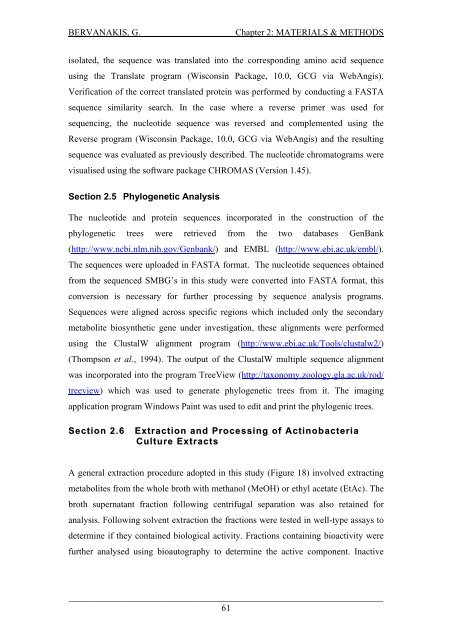Detection and Expression of Biosynthetic Genes in Actinobacteria ...
Detection and Expression of Biosynthetic Genes in Actinobacteria ...
Detection and Expression of Biosynthetic Genes in Actinobacteria ...
You also want an ePaper? Increase the reach of your titles
YUMPU automatically turns print PDFs into web optimized ePapers that Google loves.
BERVANAKIS, G.Chapter 2: MATERIALS & METHODSisolated, the sequence was translated <strong>in</strong>to the correspond<strong>in</strong>g am<strong>in</strong>o acid sequenceus<strong>in</strong>g the Translate program (Wiscons<strong>in</strong> Package, 10.0, GCG via WebAngis).Verification <strong>of</strong> the correct translated prote<strong>in</strong> was performed by conduct<strong>in</strong>g a FASTAsequence similarity search. In the case where a reverse primer was used forsequenc<strong>in</strong>g, the nucleotide sequence was reversed <strong>and</strong> complemented us<strong>in</strong>g theReverse program (Wiscons<strong>in</strong> Package, 10.0, GCG via WebAngis) <strong>and</strong> the result<strong>in</strong>gsequence was evaluated as previously described. The nucleotide chromatograms werevisualised us<strong>in</strong>g the s<strong>of</strong>tware package CHROMAS (Version 1.45).Section 2.5 Phylogenetic AnalysisThe nucleotide <strong>and</strong> prote<strong>in</strong> sequences <strong>in</strong>corporated <strong>in</strong> the construction <strong>of</strong> thephylogenetic trees were retrieved from the two databases GenBank(http://www.ncbi.nlm.nih.gov/Genbank/) <strong>and</strong> EMBL (http://www.ebi.ac.uk/embl/).The sequences were uploaded <strong>in</strong> FASTA format. The nucleotide sequences obta<strong>in</strong>edfrom the sequenced SMBG’s <strong>in</strong> this study were converted <strong>in</strong>to FASTA format, thisconversion is necessary for further process<strong>in</strong>g by sequence analysis programs.Sequences were aligned across specific regions which <strong>in</strong>cluded only the secondarymetabolite biosynthetic gene under <strong>in</strong>vestigation, these alignments were performedus<strong>in</strong>g the ClustalW alignment program (http://www.ebi.ac.uk/Tools/clustalw2/)(Thompson et al., 1994). The output <strong>of</strong> the ClustalW multiple sequence alignmentwas <strong>in</strong>corporated <strong>in</strong>to the program TreeView (http://taxonomy.zoology.gla.ac.uk/rod/treeview) which was used to generate phylogenetic trees from it. The imag<strong>in</strong>gapplication program W<strong>in</strong>dows Pa<strong>in</strong>t was used to edit <strong>and</strong> pr<strong>in</strong>t the phylogenic trees.Section 2.6Extraction <strong>and</strong> Process<strong>in</strong>g <strong>of</strong> Act<strong>in</strong>obacteriaCulture ExtractsA general extraction procedure adopted <strong>in</strong> this study (Figure 18) <strong>in</strong>volved extract<strong>in</strong>gmetabolites from the whole broth with methanol (MeOH) or ethyl acetate (EtAc). Thebroth supernatant fraction follow<strong>in</strong>g centrifugal separation was also reta<strong>in</strong>ed foranalysis. Follow<strong>in</strong>g solvent extraction the fractions were tested <strong>in</strong> well-type assays todeterm<strong>in</strong>e if they conta<strong>in</strong>ed biological activity. Fractions conta<strong>in</strong><strong>in</strong>g bioactivity werefurther analysed us<strong>in</strong>g bioautography to determ<strong>in</strong>e the active component. Inactive_____________________________________________________________________61















